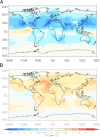Reduced anthropogenic aerosol radiative forcing caused by biogenic new particle formation
- PMID: 27790989
- PMCID: PMC5087035
- DOI: 10.1073/pnas.1602360113
Reduced anthropogenic aerosol radiative forcing caused by biogenic new particle formation
Abstract
The magnitude of aerosol radiative forcing caused by anthropogenic emissions depends on the baseline state of the atmosphere under pristine preindustrial conditions. Measurements show that particle formation in atmospheric conditions can occur solely from biogenic vapors. Here, we evaluate the potential effect of this source of particles on preindustrial cloud condensation nuclei (CCN) concentrations and aerosol-cloud radiative forcing over the industrial period. Model simulations show that the pure biogenic particle formation mechanism has a much larger relative effect on CCN concentrations in the preindustrial atmosphere than in the present atmosphere because of the lower aerosol concentrations. Consequently, preindustrial cloud albedo is increased more than under present day conditions, and therefore the cooling forcing of anthropogenic aerosols is reduced. The mechanism increases CCN concentrations by 20-100% over a large fraction of the preindustrial lower atmosphere, and the magnitude of annual global mean radiative forcing caused by changes of cloud albedo since 1750 is reduced by [Formula: see text] (27%) to [Formula: see text] Model uncertainties, relatively slow formation rates, and limited available ambient measurements make it difficult to establish the significance of a mechanism that has its dominant effect under preindustrial conditions. Our simulations predict more particle formation in the Amazon than is observed. However, the first observation of pure organic nucleation has now been reported for the free troposphere. Given the potentially significant effect on anthropogenic forcing, effort should be made to better understand such naturally driven aerosol processes.
Keywords: aerosol; biogenic; climate; forcing.
Conflict of interest statement
The authors declare no conflict of interest.
Figures




References
-
- Went FW. Blue hazes in the atmosphere. Nature. 1960;187(4738):641–643.
-
- Merikanto J, Spracklen DV, Mann GW, Pickering SJ, Carslaw KS. Impact of nucleation on global CCN. Atmos Chem Phys. 2009;9(21):8601–8616.
-
- Kavouras IG, Mihalopoulos N, Stephanou EG. Formation of atmospheric particles from organic acids produced by forests. Nature. 1998;395(6703):683–686.
-
- Riccobono F, et al. Oxidation products of biogenic emissions contribute to nucleation of atmospheric particles. Science. 2014;344(6185):717–721. - PubMed
Publication types
MeSH terms
Substances
LinkOut - more resources
Full Text Sources
Other Literature Sources

